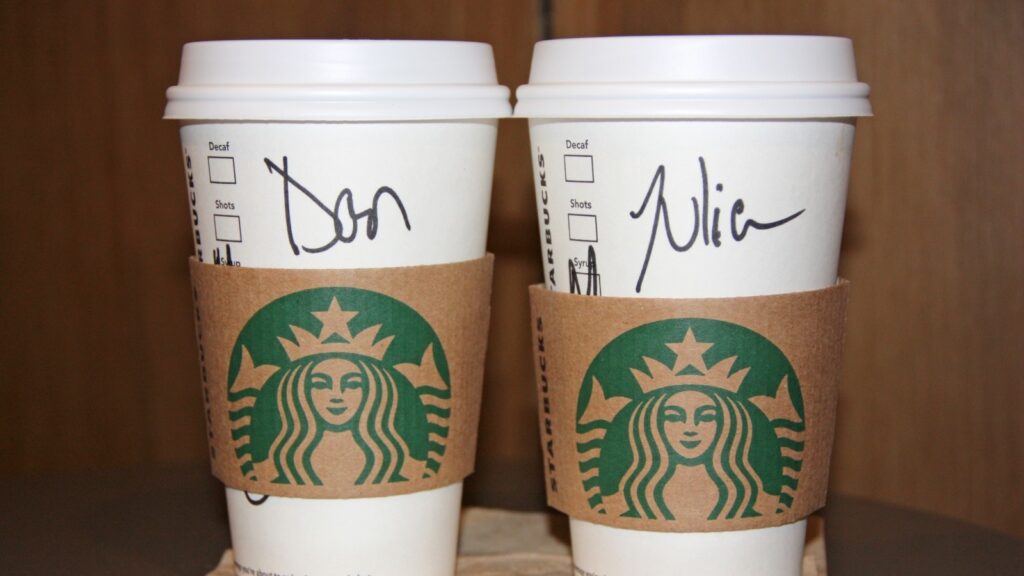Starbucks has long been celebrated for its ability to create unique and memorable customer experiences. Among its many innovative ideas, one that stands out is the campaign where the brand announced they would start writing customers’ names on their cups. This initiative wasn’t just a quirky gimmick it became a hallmark of the Starbucks experience, symbolizing connection, personalization, and customer-centric branding.
The Ad: A Creative Introduction to Personalization
The ad announcing this shift was as creative as the idea itself. It showcased a Starbucks cup with a hand-drawn story, capturing the excitement of adding a human touch to every order. With simplicity and elegance, the ad conveyed that Starbucks wasn’t just about coffee it was about making each customer feel valued and unique.
By writing names on cups, Starbucks aimed to create a direct connection with its customers. It was an invitation to make their coffee experience more personal, memorable, and engaging. The ad resonated with audiences worldwide, marking the start of a trend that other brands would later emulate.
Advantages of the Name-on-Cups Campaign
- Personalization at Its Best: Writing a customer’s name on their cup made the experience more personal, helping Starbucks foster a deeper emotional connection with its patrons.
- Viral Marketing Potential: The quirky and sometimes humorous misspellings of names became an internet sensation, sparking countless social media posts, memes, and free publicity for the brand.
- Improved Customer Engagement: The initiative encouraged customers to share their Starbucks moments, enhancing loyalty and making Starbucks cups iconic symbols of their coffee culture.
- Brand Differentiation: This unique approach helped Starbucks stand out in a competitive market, reinforcing its position as a leader in the coffee industry.
- Memorability: Customers began to associate their Starbucks experience not just with coffee but with the personal touch of having their name on the cup, making it a lasting impression.
Disadvantages of the Name-on-Cups Campaign
- Errors and Frustrations: Misspelling names, though humorous for some, could also frustrate customers who felt their names weren’t taken seriously.
- Time-Consuming: Writing names on cups, especially during peak hours, added extra time to the ordering process, potentially delaying service.
- Privacy Concerns: In some regions, customers expressed concerns about privacy, as calling out names could feel intrusive or uncomfortable for some.
- Cultural Sensitivity: In diverse markets, the campaign faced challenges when handling unique or culturally specific names, leading to occasional misunderstandings.
- Execution Challenges: Ensuring consistent implementation across thousands of Starbucks locations required extensive training and monitoring, making it a logistical challenge.
Why This Campaign Worked
Despite its challenges, the name-on-cups campaign became a defining feature of the Starbucks brand. Its success lay in its ability to connect with customers on a personal level while simultaneously creating a buzz that kept Starbucks top-of-mind. The brand’s willingness to embrace imperfection like the misspelled names only added to its charm, making it more relatable and human.

Lessons for Brands
- Human Touch Matters: In a digital world, small gestures like writing a name can create a lasting emotional connection with customers.
- Leverage User-Generated Content: Starbucks turned everyday interactions into shareable moments, amplifying its reach through customer-driven content.
- Be Bold and Unique: Introducing something unconventional can differentiate your brand and create a competitive advantage.
- Adapt to Challenges: Starbucks showed that even with minor flaws, a well-intentioned campaign can be overwhelmingly successful if handled with authenticity.
Starbucks: Beyond Coffee
The name-on-cups initiative highlighted Starbucks’ ability to think beyond its core product. It wasn’t just selling coffee—it was selling a culture, an experience, and a sense of belonging. By turning something as simple as a coffee cup into a symbol of connection, Starbucks demonstrated its mastery in creating customer-centric campaigns that stand the test of time.
Even years later, the name-on-cups campaign is remembered as a bold move that redefined the customer experience. It’s a testament to Starbucks’ commitment to innovation and its understanding of what customers truly value: not just good coffee, but a personal, memorable experience


